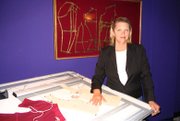Talking CAD With PAD's Kristine Gloviak
Computerized pattern-making and design (CAD) has played a large part in the speed-to-market game as designers and companies are pressured to roll out collections more quickly. CAD companies have advanced their products over the past few years with new 3-D and nesting tools and have integrated into other areas such as body scanning, as well.
One of the leaders in CAD technology has been PAD System Technologies, which is distributed in the United States by Los Angeles–based GCL Distribution. Kristine Gloviak is vice president of the company and has more than 20 years of experience in CAD/CAM practice, sales, training and development. She has spoken on numerous design panels around the country and sits on the board of advisors for California State Polytechnic University, Pomona. She was instrumental in bringing PAD to Pixar Animation Studios, which used PAD’s Master Pattern Design and Made-to-Measure applications during a number of animation films with Disney. California Apparel News Technology Editor Robert McAllister recently met with Gloviak for a Q&A session about the latest developments in CAD.
How would you characterize the state of CAD in the United States right now?
Is it following the lead of outsourced labor and leaving the United States?Computerized pattern-making is actually on the rise. We have been training new users at a very high volume over the past six months. Patternmakers have to embrace the digital world, as most of the patterns produced are being e-mailed to many remote locations where contractors use a variety of systems to cut and sew clothing for the U.S.
Manufacturing bases in Los Angeles still do a lot of manual pattern-making. Is it a big adjustment to adopt CAD?
The hardest transition from manual pattern cutting to computer is the change in proportion of your working area. We suggest that pattern creators zoom up often to 100 percent and plot the work as often as possible to get the same feeling as the actual-size pattern drafted to the body manually. Manually draping delicate fabrics on the mannequin is very much still in the creative process. Then those draped fabrics, or muslins, are “digitized into a computer” to obtain seam allowance, perfecting the fit and balance of the draped pattern. Pattern-making is all about making many tiny adjustments to the fit and drape of a garment, from the creation of the “first” (a.k.a. rough sketch of the style) to “production” patterns, which in most cases have to follow a certain measurement the store or manufacturer dictates to be the “perfect-fitting size 10”or “the most-popular-fitting medium.”
With the amount of CAD being done offshore, do you think design will follow?
The ideas for designing apparel will remain in the U.S. New York and California create the most trend-setting apparel ideas for the whole world, which can be seen in [everything from] award-winning films and television shows to the high-end apparel on runways in the fashion capitals of the world.
What’s new with PAD right now and CAD in general? What features/functions are pattern designers looking for?
The newest thing in CAD right now is major advancement of automatic marker making, which allows patternmakers to obtain a “yield,” or fabric consumption. All the major apparel CAD vendors have special automatic nesting programs, which are now very advanced as they can be done quickly for size-by-size markers, markers with patterns that have block-fusing, and markers with plaid and stripe matching. PAD is popular because of its “click-less” reputation. The software has been called “the designer software” because it is the closest to intuitive manual drawing as the pencil and ruler. There are many duplicate pieces in a garment. The lining pieces, for example, are a similar shape to the main fabric, and CAD is able to make these duplicate pieces very quickly.
With all the different systems and users out there, how are companies addressing file conversions at the factory level?
File transfer is a huge business. The various ways digital patterns can be read in multiple systems is a very elaborate subject. We are suggesting this subject be a featured class in fashion schools using PAD and other systems. There are many ways for patterns to travel from one system to another, and PAD is very involved in training its users and users from other systems [in] the best way to transfer files.
How is 3-D being adopted as part of CAD? Are we still in the early stages?
3-D is great for simple garments and for garments made by animators for cartoons and video games. 3-D for actual human apparel is still in development. The human body is like an amoeba, and each fabric type has a very unique behavior when put on a real human body. Therefore, designers still want to see their styles actually sewn in the real fabric. Simulating fabric is time-consuming and comes close to the real thing, but still the actual draping of the real fabric rules at this point in time.
What’s the future of CAD? Do you see areas such as body-scanning technology playing a bigger part?
Body scanners are important, but at this point, they carry a very high price. The future of body scanning will be in low-cost versions, which take the common measurements on the back of mail-order catalogs so that people can know—automatically and quickly—what size they were from one manufacturer to another. Body scanning to find a size that fits you is coming right around the corner. Cal Poly Pomona’s Apparel Manufacturing & Management’s research department is examining low-cost body scanning. I see its use and implementation as useful as the ATM machine, and it is right around the corner for apparel-size searching and for custom-made clothing.






















